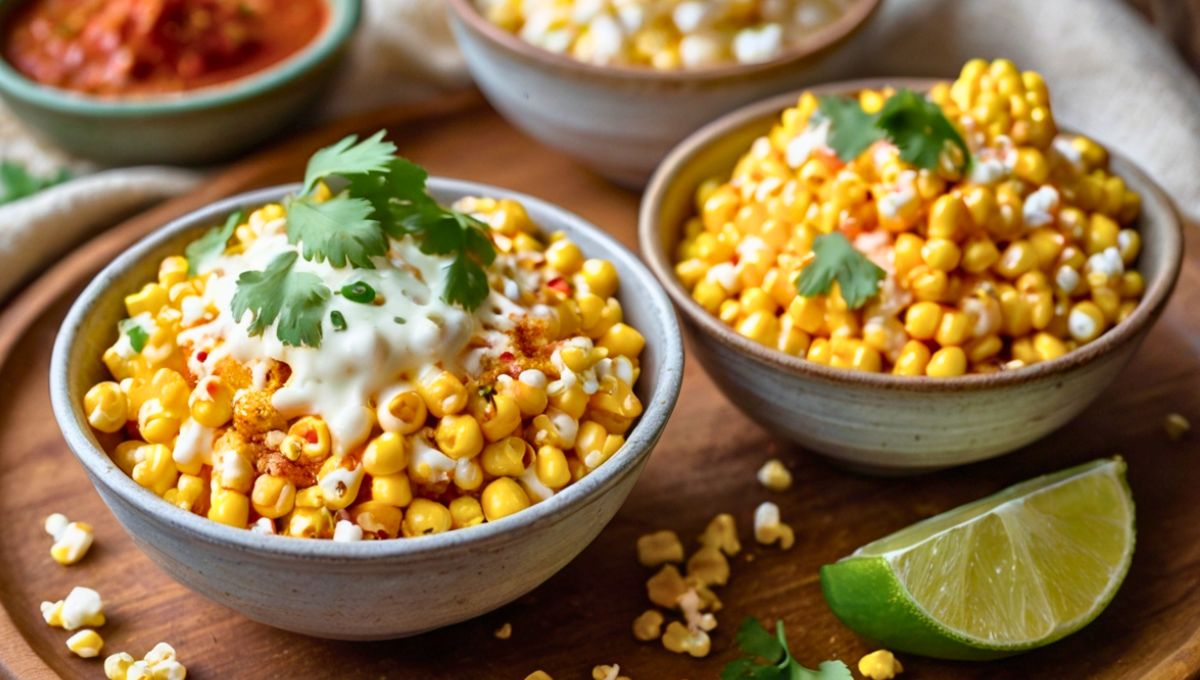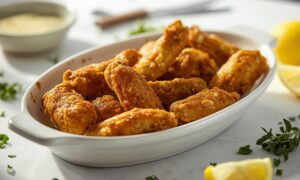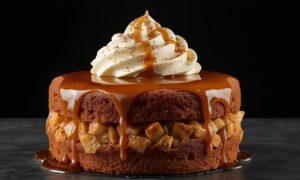Esquites Mexican Corn in a Cup were first introduced to me on a sweltering summer evening in Mexico City’s historic center. A street vendor with weathered hands and a warm smile served me this magical concoction in a Styrofoam cup, steaming hot corn kernels swimming in a savory elixir, topped with a flurry of cotija cheese, Chile powder, and lime. That first spoonful? Pure revelation. How could something so simple deliver such complex flavors?
Esquites (pronounced es-KEE-tays) represents Mexican street food at its finest approachable yet sophisticated, humble yet indulgent. Its name derives from the Nahuatl word “izquitl,” meaning “toasted corn,” honoring its pre Hispanic origins. While its charred, cup bound cousin elote (corn on the cob) might grab more international attention, many Mexicans actually prefer Esquites Mexican Corn in a Cup for their practicality and intensity of flavor.
Let’s dive into what makes this dish so special and how you can recreate authentic esquites at home that’ll transport you straight to the bustling streets of Mexico.
Ingredients & Substitutions
The Foundation: Corn
Fresh corn provides the soul of esquites. Ideally, look for white corn (common in Mexican cooking) with plump, firm kernels. Yellow sweet corn works well too, but the subtly starchier Mexican varieties deliver unparalleled authenticity. During off seasons, frozen corn can substitute adequately, just ensure it’s not the super sweet variety that might throw off the balance.
I’ve found that 4-5 large ears yield the perfect amount for 4 servings. When selecting corn, peel back the husk slightly to check for bright, plump kernels without browning or drying. Fresh silks indicate recent harvest, which translates to maximum sweetness and texture.
The Flavor Builders
- Epazote: This traditional herb imparts a distinctive, almost medicinal quality that’s irreplaceable. If unavailable (likely outside Mexico), substitute with a combination of cilantro and a tiny pinch of savory oregano. Not identical, but respectful of the original intent.
- Garlic and Onion: Fresh is non negotiable here. Pre minced garlic lacks the essential volatile compounds that dissipate quickly after processing.
- Chile: Authentic esquites typically feature either chile powder (like chile de árbol) or fresh serrano/jalapeño. The powdered variety offers consistency, while fresh peppers bring brightness that evolves as the dish sits. Choose according to your heat prefrence and availability.
The Finishing Elements
- Mayonnaise: Controversial among purists but increasingly common in modern preparations. Mexican mayo tends to be tangier than American varieties, so consider adding a splash of lime if using the latter.
- Mexican Crema: Silkier and less tangy than sour cream. Substitute with crème fraîche or a mixture of sour cream thinned with heavy cream.
- Cotija Cheese: This dry, salty cheese is ideal but can be replaced with crumbled feta (rinse first to reduce saltiness) or even parmesan in desperate situations.
- Lime: Non negotiable. Period. The brightest, juiciest specimens you can find.
- Chile Powder/Tajín: These aren’t just garnishes but essential flavor components. Tajín brings citrusy notes along with heat, while traditional chile powders offer deeper, smokier profiles.
Esquites Mexican Corn in a Cup: Step by Step Guide
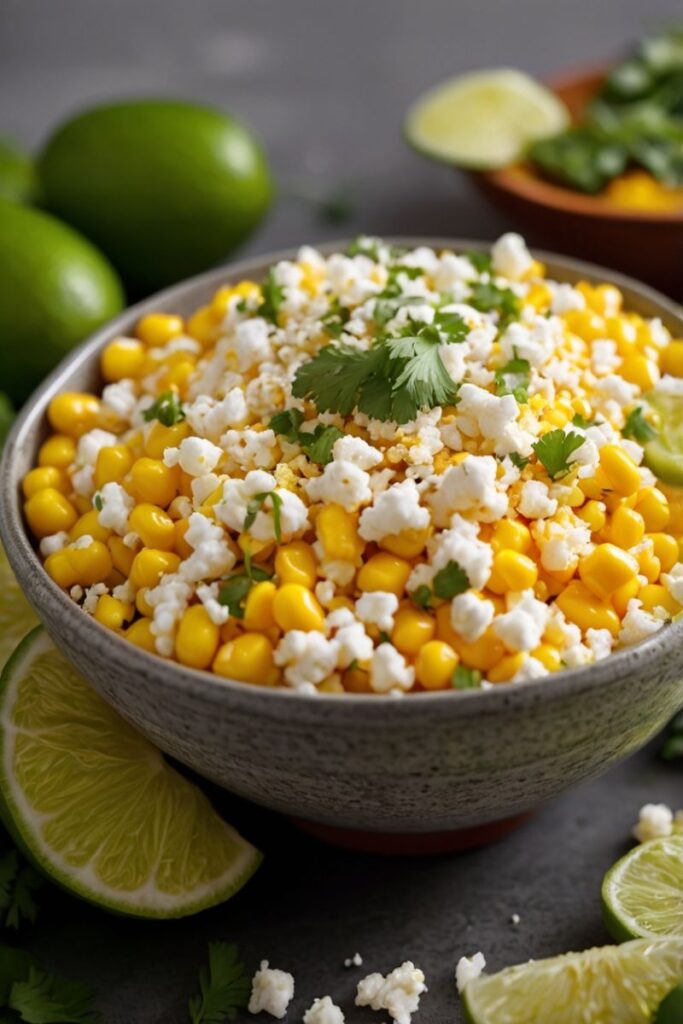
Preparing the Corn
- Cutting and Cleaning: Stand each ear upright on its stem end and use a sharp knife to cut downward, removing kernels in strips. Work your way around the cob. Pro tip: Place the ear in a wide bowl to catch wayward kernels that inevitably try to escape. A common mistake is cutting too close to the cob, leave a slight bit of kernel attached to avoid the woody base.
- The Essential Char: While some modern recipes skip this step, charring is what elevates good esquites to transcendent ones. Heat a heavy cast iron or carbon steel pan until smoking hot. Add corn in a single layer (working in batches if necessary) and let it sit undisturbed for 45-60 seconds. The goal isn’t to continuously stir but to develop those magical browned spots that contribute smoky complexity.
- Patience Pays: Resist the urge to constantly stir the corn. Let those kernels develop a proper char before tossing. You want about 30-40% of each kernel surface to show caramelization. When done correctly, the kitchen should fill with a toasty aroma that’ll make your mouth water in anticipation.
Building the Base
- Aromatics First: In a medium saucepan, heat 1-2 tablespoons of oil (neutral or butter, or the traditional lard if you’re feeling authentic). Add finely diced onion (about ¼ cup) and sauté until translucent but not browned. Add 2 minced garlic cloves and cook just until fragrant, about 30 seconds. The garlic should never brown this introduces bitterness that will permeate the entire dish.
- The Crucial Simmer: Add the charred corn to the aromatics along with 2-3 sprigs of epazote (or substitute), a generous pinch of salt, and just enough chicken stock or water to barely cover the corn. Bring to a gentle simmer, then reduce heat to maintain a bare bubble. Cook uncovered for 7-10 minutes, allowing the liquid to reduce slightly while the corn absorbs the flavors.
- Liquid Management: The final consistency should be moist but not soupy corn kernels glistening with enough cooking liquid to form a light sauce but not swimming in broth. If needed, increase heat slightly at the end to reduce excess liquid, or add a tablespoon more stock if too dry.
Assembly and Serving
- Portioning: Traditional service is in cups or small bowls while the mixture is still warm. The heat slightly melts the cheese and creates a delicious temperature contrast with the cool garnishes.
- Layering Technique: The proper build matters. Start with a generous spoonful of the warm corn mixture including some of its juices. Add a tablespoon each of mayonnaise and crema, then a generous squeeze of lime. Top with crumbled cotija, a dusting of chile powder, and finish with chopped cilantro.
- The Final Touch: Always serve with extra lime wedges and additional chile powder on the side—personal preference varies widely in the ideal ratio of these finishing elements. Providing lime and chile on the side allows eaters to adjust acidity and heat to their liking.
Cooking Techniques & Science
The Maillard Magic
The characteristic depth of esquites comes primarily from the Maillard reaction, that miraculous chemical process where proteins and sugars in the corn transform under high heat, creating hundreds of new flavor compounds. This isn’t just browning; it’s a fundamental transformation that creates notes of nuts, caramel, and even coffee like complexity.
Achieving proper Maillard requires dry heat and patience. Excess moisture prevents temperatures from reaching the necessary threshold (generally above 300°F/150°C). That’s why properly drying your corn kernels with paper towels before charring pays such dividends in flavor.
Starch Behavior and Texture Development
Corn’s natural starches play a crucial role in esquites’ distinctive textural identity. As the kernels simmer, these starches partially gelatinize, creating that characteristic “bite” that sets excellent esquites apart from merely good ones.
The simmering stage isn’t just about flavor infusion but also texture development. Too brief, and the corn retains a raw starchiness; too long, and kernels turn mushy. The sweet spot usually 7-10 minutes of gentle simmer yields corn that’s tender but with a pleasant resistance when bitten.
The Time Honored Tools
While modern kitchen gadgets might expedite certain steps, traditional preparation relies on simple tools that actually produce superior results:
- Comal: This flat griddle allows for ideal charring because of its even heat distribution and shallow profile that promotes moisture evaporation.
- Molinillo: Though not used directly in esquites preparation, this traditional whisk creates the perfectly aerated texture if incorporating Mexican hot chocolate into more experimental variations.
- Wooden Implements: Traditional cooks avoid metal utensils when stirring, particularly during the simmering phase, believing that wood preserves delicate flavors better than reactive metals.
Perfect Pairings for Esquites Mexican Corn in a Cup
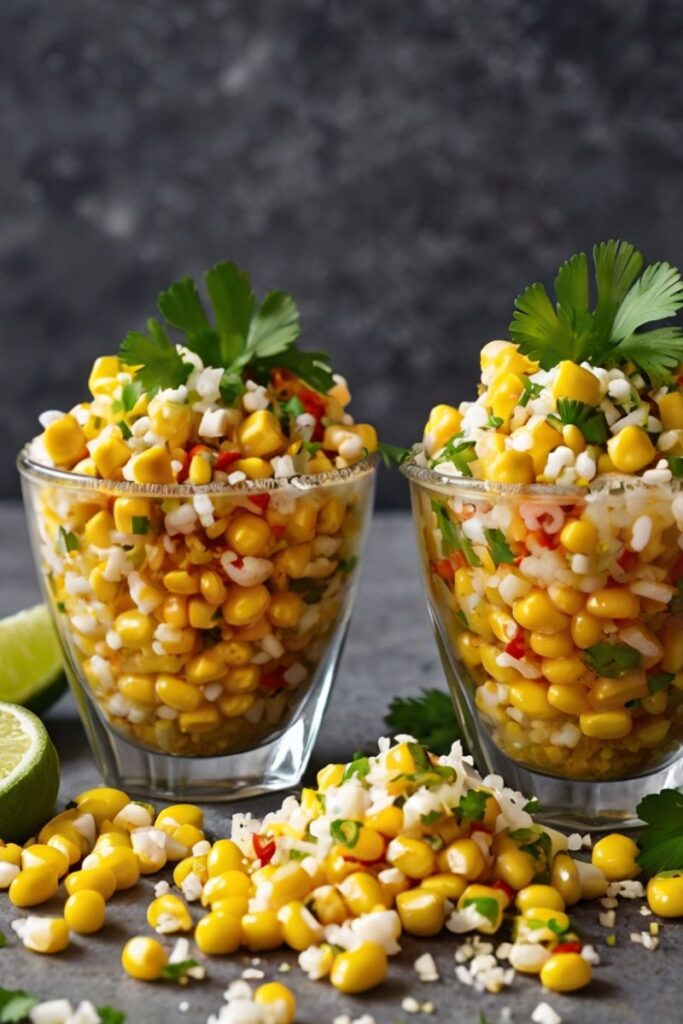
Presentation Possibilities
Traditional esquites service is blissfully straightforward simple cups with plastic spoons handed across a street vendor’s counter. But home service allows for thoughtful presentation that honors the dish while elevating the experience:
- Vessel Selection: Small, clear glasses showcase the beautiful layering of ingredients and allow diners to see the colorful strata before mixing. Mexican clay cups (jarros) offer rustic authenticity and help maintain temperature.
- Garnish Architecture: Rather than mixing all toppings, consider a deliberate arrangement cotija cheese on one side, chile powder on another, with a lime wedge perched on the rim allowing diners to appreciate the individual components before they’re combined.
- Temperature Contrast: Serve the corn mixture warm while keeping all garnishes thoroughly chilled. This creates a delightful hot cold interplay that elevates the sensory experience.
Ideal Companions
Esquites performs beautifully alongside a variety of Mexican classics:
- Tacos al Pastor: The fruity, spicy pork creates magical harmony with the creamy, charred corn.
- Chilled Soups: A small cup of esquites pairs magnificently with a bowl of chilled cucumber or avocado soup in summer months.
- Grilled Meats: The charred notes in both esquites and grilled proteins create a natural flavor bridge. Particularly magical with carne asada.
Beverage Pairings
The ideal beverage pairing respects both the dish’s creamy richness and spicy complexity:
- Mexican Lagers: The crisp, clean profile of beers like Pacifico or Modelo Especial cuts through the richness while not overpowering the delicate corn flavor.
- Micheladas: This savory beer cocktail with its spicy, umami notes creates a surprising flavor synergy.
- Aguas Frescas: For non alcoholic options, the gentle sweetness of horchata or hibiscus agua fresca provides pleasant contrast.
- Wine: If wine is preferred, a mildly oaked Chardonnay echoes the corn’s buttery quality, while a bright Sauvignon Blanc with herbal notes complements the epazote and cilantro.
Final Thoughts on Esquites: Mexican Corn in a Cup
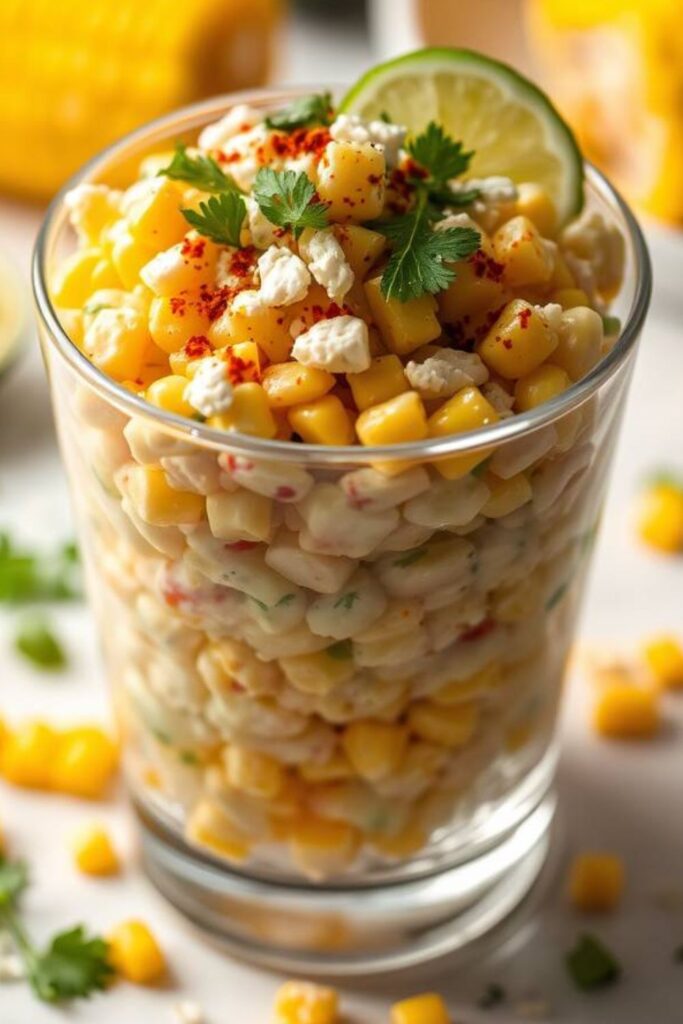
Esquites (Mexican Corn in a Cup) showcases Mexican cuisine at its finest layers of flavor built from humble ingredients, elevated by thoughtful technique. Its magic lies in the harmony of each element: charred sweet corn, herbal epazote, creamy mayo and crema, salty cotija, and the bright zing of lime.
What sets exceptional Esquites (Mexican Corn in a Cup) apart is attention to detail perfectly charred corn, slow simmering with epazote, and balanced toppings that enhance without overpowering.
Master this dish, and you’re embracing more than a recipe, you’re connecting to a rich culinary tradition that spans street vendors to chefs. Whether as a snack, appetizer, or side, esquites offers a delicious balance of comfort and complexity that continues to win hearts worldwide..
FAQs about Esquites (Mexican Corn in a Cup)
Can I prepare esquites ahead of time?
You can prepare the corn base up to 2 days ahead and refrigerate. However, always add the mayonnaise, crema, cotija, and lime just before serving for optimal texture and flavor contrast. Reheat the corn mixture gently before adding toppings.
Is there a way to make authentic esquites without epazote?
While epazote gives esquites their authentic earthy flavor, you can substitute with 1 tablespoon of fresh Mexican oregano and 2 tablespoons of cilantro. This combination offers a vibrant, herbaceous twist. Though the flavor shifts slightly, it still honors the spirit of traditional esquites while keeping things accessible for home cooks without epazote..
How spicy should authentic esquites be?
Traditional esquites embrace customization, giving each person the freedom to craft their perfect bite. The optional heat, often in the form of chile powder or hot sauce on the side—allows you to dial up the spice or keep it mild. This approach ensures the natural sweetness of the corn stays front and center, harmonizing with creamy, tangy, and savory notes like lime juice, mayo, cotija cheese, and butter. It’s about celebrating the ingredients, not overpowering them—just as street vendors in Mexico have done for generations.
Can esquites be served cold?
While traditionally served warm, esquites adapted as “ensalada de elote” (corn salad) works beautifully chilled, especially in summer. If serving cold, increase lime juice slightly to brighten flavors that become more subdued at lower temperatures. Chilling enhances its refreshing quality, making it perfect for cookouts, potlucks, or light lunches. You can also add crisp veggies like bell peppers or radishes to complement the cool, creamy texture and elevate its summer appeal even more.
What’s the difference between esquites and elote?
They share identical ingredients but differ in presentation and eating experience. Elote features corn on the cob, typically grilled, while esquites uses kernels served in a cup with more sauce. Esquites offers a more intensely flavored experience since seasonings penetrate between individual kernels rather than just coating the exterior.

Swiftly Captions by Tina Smith — Quick, flavorful food recipes made simple, bringing fresh inspiration to your kitchen every day
